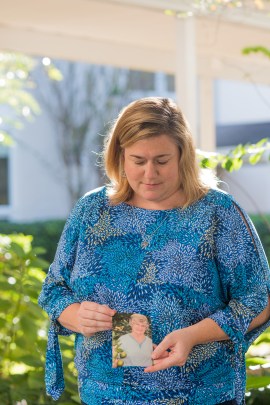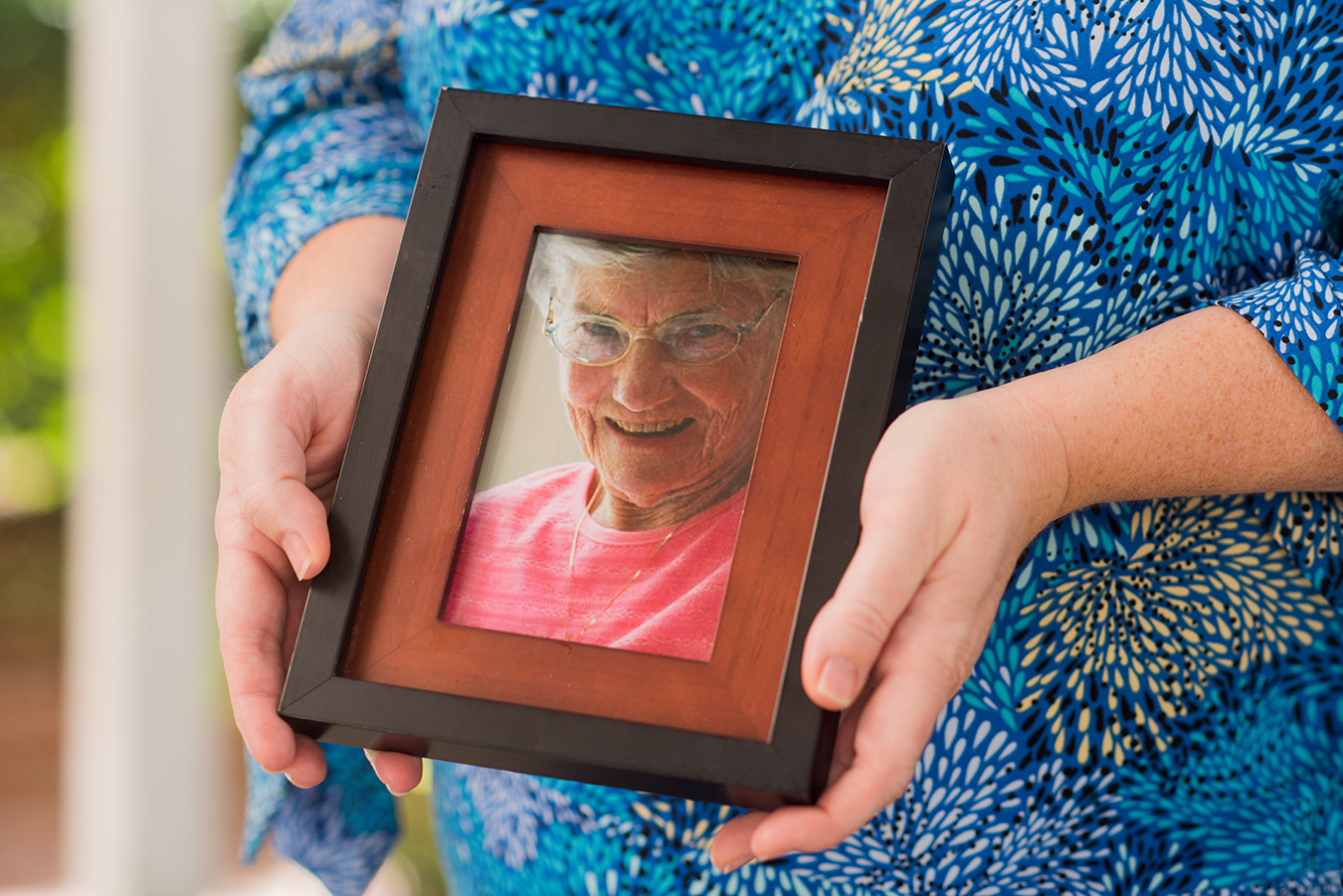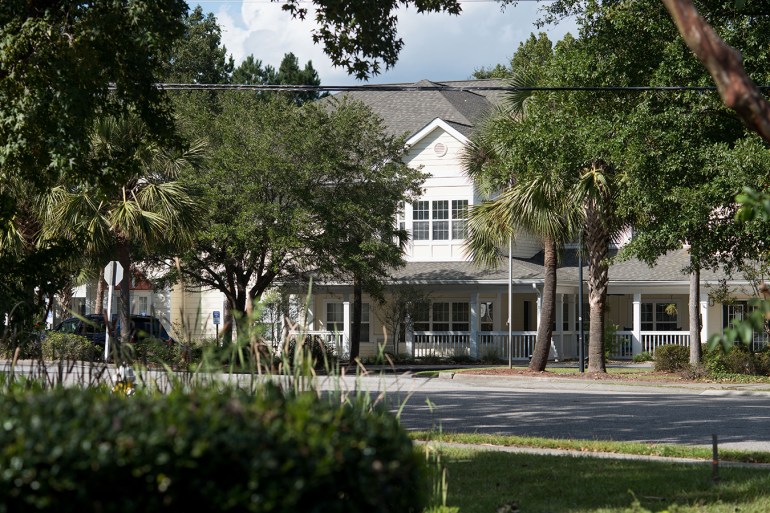They found Bonnie Walker’s body floating in a pond behind her assisted living facility in South Carolina. There were puncture wounds on her ear, her temple, her jaw and her cheeks.
Her right forearm and her pacemaker were inside one of the alligators that lived in the pond.
Like 4 in 10 residents in assisted living facilities, Walker, 90, had dementia. Shortly after midnight one day in July 2016, she slipped out of her facility, Brookdale Charleston, as she had done a few days before. This time, no one noticed her missing for seven hours.
“No one should have to pass away that way,” her granddaughter Stephanie Weaver said.

Stephanie Weaver holds a photo of her grandmother, Bonnie Walker. Weaver is suing Brookdale Charleston for emotional distress following Walker’s death in a pond behind the assisted living facility in 2016.(Leigh Webber for KHN)
Assisted living facilities were originally designed for people who were largely independent but required help bathing, eating or with other daily tasks. Unlike nursing homes, the facilities generally do not provide skilled medical care or therapy, and stays are not paid for by Medicare or Medicaid.
Dementia care is the fastest-growing segment of assisted living. As these residences market themselves to people with Alzheimer’s and other types of dementia, facilities across the country are straining to deliver on their promises of security and attentive care, according to a Kaiser Health News analysis of inspection records in the three most populous states.
In California, 45 percent of assisted living facilities have violated one or more state dementia regulations during the past five years. Three of the 12 most common California citations in 2017 were related to dementia care.
In Florida, 1 in 11 assisted living facilities have been cited since 2013 for not meeting state rules designed to prevent residents from wandering away.
And in Texas, nearly a quarter of the facilities that accept residents with Alzheimer’s have violated one or more state rules related to dementia care, such as tailoring a plan for each resident upon admission or ensuring that staff members have completed special training, according to nearly six years of records.
“There is a belief in our office that many facilities do not staff to the level” necessary to meet the unanticipated “needs of residents, especially medical needs,” said Fred Steele, Oregon’s long-term care ombudsman. “Many of these are for-profit entities. They are setting staffing ratios that maybe aren’t being set because of the care needs of the residents but are more about the bottom line of their profits.”
Uneven Regulation
These concerns, though particularly acute for people with dementia, apply to all assisted living residents. They are older and frailer than assisted living residents were a generation ago. Within a year, 1 in 5 experience a fall, 1 in 8 visit an emergency room and 1 in 12 have an overnight hospital stay, according to the Centers for Disease Control and Prevention. Half are 85 or older.
“Assisted living was created to be an alternative to nursing homes, but if you walk into some of the big assisted living facilities, they sure feel like a nursing home,” said Doug Pace, director for mission partnerships with the Alzheimer’s Association.
Yet the rules for assisted living remain looser than for nursing homes. The federal government does not license or oversee assisted living facilities, and some states set tougher rules than others.
The government does not publish quality measures as it does for nursing homes. Inspections usually are less frequent, and fines are generally far lower than what a nursing home might incur for a similar mistake.
Lindsay Schwartz, an associate vice president at the National Center for Assisted Living, an industry group, said facilities must balance safety with allowing people with dementia to move about as freely as possible and to socialize.
“Dementia is a difficult disease,” she said. “Freedom of movement is incredibly important for overall health, mind, body and spirit. You can’t keep people in isolation.”
The industry says rigid government regulations don’t mesh with the individual approaches that assisted living facilities aspire to create for residents.
But residents’ families, their lawyers and advocates say the violent behavior of agitated residents and escapes could be avoided with better training and more staff. Eliza Cantwell, a Charleston, S.C., plaintiffs’ lawyer, said too many facilities were accepting residents they weren’t prepared to adequately care for because they wanted to maximize their income.
“They don’t have the qualified personnel to take care of these people, and they’re taking care of them anyway,” she said.
Cantwell is representing Weaver in a suit against Brookdale for emotional distress, which Weaver says came from being among the first people to discover her grandmother’s body. Brookdale has already settled a wrongful-death claim from Bonnie Walker’s estate.
The company declined to discuss Weaver’s lawsuit and said in a statement that “our everyday focus and priority is to keep residents safe.” Brookdale called Walker’s death “an unfortunate accident” and said it has retrained its staff.
A year after Walker’s death, after four inspections, the South Carolina Department of Health and Environmental Control fined Brookdale for 11 violations, including not properly performing night checks and letting staffing drop below required levels. The penalty: $6,400.
“I worked as a law enforcement agent for the Department of Natural Resources, and I’ve written wildlife tickets larger than what DHEC did,” Weaver said. “This was nothing.”

Stephanie Weaver holds a photo of her grandmother, Bonnie Walker. Weaver is suing Brookdale Charleston for emotional distress following Walker’s death in a pond behind the assisted living facility in 2016.(Leigh Webber for KHN)

Bonnie Walker, a resident of Brookdale Charleston with dementia, was found floating in a pond behind the assisted living facility in July 2016, after an apparent alligator attack. Brookdale Charleston called her death “an unfortunate accident.”(Leigh Webber for KHN)

In July 2016, Brookdale Charleston resident Bonnie Walker walked near the pond shortly after midnight. She was found dead after an apparent alligator attack.(Leigh Webber for KHN)
‘Get Him Away From Me’
Nearly a quarter of the nation’s 30,000 assisted living facilities either house only people with dementia or have special areas known as memory care units. These wings have locked doors and other safeguards to prevent residents from leaving. The facilities often train staff members in techniques to manage behavior related to these diseases and provide activities to keep the residents engaged and stimulated.
These units usually are more expensive, with monthly costs averaging $6,472, compared with $4,835 for regular assisted living, according to a survey by the National Investment Center for Seniors Housing & Care, a group that analyzes elder care market trends. Senior housing investors earned nearly 15 percent in annual returns over the past five years, higher than for apartment, hotel, office and retail properties, according to the center. Beth Burnham Mace, chief economist at the center, said memory care unit construction was outpacing all other types of senior housing.
Aggressive behavior, a hallmark of dementia, is a major problem in assisted living facilities. One national study, published in 2016, found that 8 percent of assisted living residents were physically aggressive or abusive toward residents or staff.
In the dementia unit of The Point at Rockridge, an assisted living facility in Oakland, Calif., a resident identified in court papers as Ian began to follow another resident, Olivia Deloney, an 88-year-old with dementia. Before retiring, she had been dean of students at a school for the blind.
“That man is crazy,” one employee recalled Deloney saying, according to the employee’s sworn statement. “Get him away from me.”
In September 2015, Ian grabbed Deloney and threw her to the ground, breaking her right hip, a video shows. When paramedics were putting her into a stretcher, Ian tried to kick her, and the emergency workers had to keep him away, the police report said.
Afterward, the administrators told Deloney’s daughter, Simone Stevens, that they had not known that Ian, a retired university facilities engineer, was dangerous, her lawsuit said.
“They just made it sound like it was like a freak accident: ‘He’s really just a calm and likable resident,’” Stevens said in an interview.
A state investigation report said The Point had been trying to address his behavioral problems before the attack. State regulators declined to punish The Point, saying in their report that there was “insufficient” evidence that the facility had “clear knowledge” Ian would be a danger to other residents.
But when Stevens sued The Point, her lawyer, Felicia Curran, discovered that Ian’s agitated behavior, including pushing and shoving, had been the reason his wife initially placed him there. At The Point, he had punched one aide in the shoulders, grabbed another by the neck and jumped on a third and beaten her, employees said in statements taken by Curran.
“It was an everyday thing for him to chase staff and be physically aggressive,” one declared. Aides posted a photo of him in their kitchen, warning colleagues to watch out for his violent outbursts, and employees once locked themselves in bathrooms for protection, according to records in the case.
“They should have never had him there in the first place,” Stevens said.
Tracee DeGrande, the president of Integral Senior Living, which owns The Point, wrote in a statement that the episode was not typical. “Our staff associates work hard to care for residents, many of whom would have nowhere to go if we didn’t provide a place for those living with dementia and Alzheimer’s disease,” she wrote.
After the attack, The Point evicted Ian. Deloney returned to the facility, but, less stable after surgery, she fell and broke her hip again. She stopped eating and died that December, according to her family’s lawsuit, which blamed The Point for not increasing supervision in light of Deloney’s weakened state.
The Point paid $1.9 million to settle the case. DeGrande wrote that the “settlement was in no way an admission of responsibility for what ended up as a difficult and sad situation.”
To calm agitated residents, some facilities are too reliant on psychotropic drugs, which carry increased risk of strokes, falls and confusion. An in-progress study funded by the National Institutes of Health has discovered that 27 percent of residents with dementia take an antipsychotic medication, and most lack documentation assuring the drugs are justified, said the lead investigator, Sheryl Zimmerman, a health researcher at the University of North Carolina at Chapel Hill.
Zimmerman said such drugs are often not necessary if residents are cared for by experienced aides who can de-escalate troubling behaviors and know techniques that engage and soothe those with dementia. But she said low pay and frequent turnover make that difficult. “The workforce could be better trained than they are,” Zimmerman said.
Requirements Vary By State
Staffing and training requirements vary greatly from state to state. A study published in 2016 and led by Paula Carder, a professor at Portland State University, found that only seven states required facilities to have a registered nurse. States required anywhere from two to 30 hours of training for dementia unit workers. A handful of states required no specialized training, according to the study. Carder found that 19 states set minimum staff-to-resident ratios for dementia units, while the others left it to the facilities.
North Carolina requires one of the tightest staffing ratios in the nation for dementia units: one worker for every eight residents during the day and evening.
Many of these are for-profit entities. They are setting staffing ratios that maybe aren’t being set because of the care needs of the residents but are more about the bottom line of their profits.
In a lawsuit, Michele Mullen asserted that Franklin Manor Assisted Living in Youngsville, N.C., did not meet North Carolina’s staffing minimums on a third of the days her mother, Claire Murphy, lived there in 2015 and 2016.
She said she would find her mother with her pants wet with urine all the way down to her knees, according to a deposition she gave in the lawsuit. Mullen said aides had repeatedly misplaced her mother’s walker. She would see her mother holding onto the hallway railing as she tried to get to her room. On New Year’s Day in 2016, her mother fell and was hospitalized for a fractured arm.
Gregory Nicoluzakis, the general counsel for Saber Healthcare Group, which owns Franklin Manor, said in an email that Mullen’s allegations were inaccurate. “We believe it is telling that Ms. Mullen admitted her mother to our facilities on three separate occasions despite having the choice of other providers,” he wrote.
Drew Hathaway, an attorney for Mullen, said there were no better alternatives nearby that had memory care units. “There are not that many facilities in these rural areas,” Hathaway said. “That’s the sad reality.”
Franklin Manor was fined in 2016 for not following doctors’ orders that two residents needed to use walkers. In February, the state cited it for not supervising five residents, all with histories of falling, who had fallen and injured themselves. Nicoluzakis said Franklin Manor was in compliance with state regulations.
Mullen ultimately removed her mother from Franklin Manor; Murphy died last December.
“I would say, ‘Mom needs to go to the bathroom.’ ‘Mom needs help with this,’” Mullen recalled in her deposition. “And they would look at me and actually say, ‘Why don’t you do it?’”
KFF Health News' coverage of these topics is supported by The SCAN Foundation and Gordon and Betty Moore Foundation







